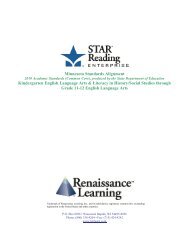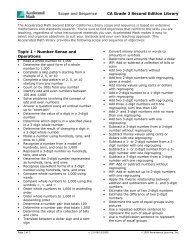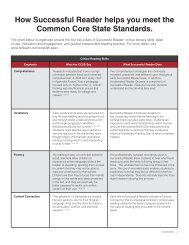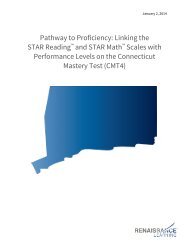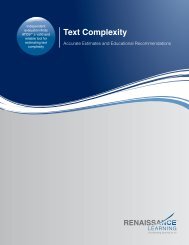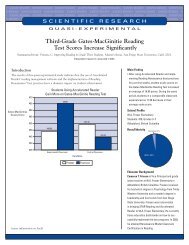ValidityPost-Publication Study DataAs shown in Table 25, for tests given in Fall 2003 the correlation coefficientsbetween the MLPP tests and STAR Early Literacy Scaled Scores were between 0.56and 0.82; all are statistically significant. The strength of this relationship indicatesthat STAR Early Literacy measures a significant number of the same skillsmeasured by the MLPP tests. For Spring 2004 scores, the range of correlations issimilar. Most of the Spring 2004 correlations have been corrected for rangerestriction, to account for ceiling effects 6 on the MLPP tests. Ceiling effectsaffected all but two of the Spring 2004 MLPP tests (Word Lists and Known Words.)To estimate what the correlation would have been had there been no ceiling effecton the MLPP tests, the McNemar correction formula was applied. It takes intoaccount the variance of scores in both Fall and Spring. The correction was notapplied to correlations with the two MLPP tests for which the ceiling effect was notevident.A complete description of the MLPP Validation Study, including correlation ofMLPP tests with STAR Early Literacy Domain Scores, is presented in CorrelationBetween Michigan Literacy Progress Profile and STAR Early Literacy, an April 2005report. To request a free copy, call <strong>Renaissance</strong> <strong>Learning</strong> at 1-800-338-4204.Table 25:STAR Early Literacy Scaled Score Correlations with Michigan LiteracyProgress Profile Raw Scores, Combined K and 1Fall 2003 Spring 2004TestN r N rConcepts of Print 245 0.74 219 0.74Letter Name 245 0.76 219 0.72Letter Sounds 245 0.80 219 0.74Word List 245 0.62 219 0.81Known Words 245 0.70 219 0.66Rhyming 245 0.56 219 0.53Dictation 245 0.82 219 0.76Segmenting 245 0.69 219 0.57Blending 245 0.71 219 0.736. Ceiling effects occur when the overall ability level of students exceeds the difficulty level of the testitems, resulting in a score distribution with a large proportion of the students attaining the highestpossible scores on the test. Ceiling effects attenuate the magnitudes of correlation coefficients byreducing test score variance. A statistical “correction for range restriction” is intended to correctthis.STAR Early Literacy<strong>Technical</strong> <strong>Manual</strong>68
ValidityPost-Publication Study DataDIBELS, GRADE, and TPRIIn September and October, 2004, <strong>Renaissance</strong> <strong>Learning</strong> conducted a study of therelationships of STAR Early Literacy scores and scores on three widely used earlyliteracy assessments: DIBELS, 7 TPRI, 8 and GRADE. 9 These assessments werechosen for study because they measure most or all of the five critical skillsidentified in the 2000 report of the National Reading Panel: PhonologicalAwareness, Phonics, Vocabulary, Text Comprehension, and Fluency. Two of them,DIBELS and TPRI, are widely used for assessment within Reading First programs.Following is a short summary of the tests administered within each assessment.DIBELS—The following tests were administered at the grades indicated: Initialsound fluency (ISF), letter naming fluency (LNF), phoneme segmentation fluency(PSF), nonsense word fluency (NWF) and word usage fluency (WUF) wereadministered to kindergartners. First graders took letter naming fluency (LNF),phoneme segmentation fluency (PSF), nonsense word fluency (NWF), word usagefluency (WUF), oral reading fluency (ORF), and retell fluency (RF). Second graderstook just four assessments: nonsense word fluency (NWF), word usage fluency(WUF), oral reading fluency (ORF), and retell fluency (RF). At their discretion, someteachers omitted specific assessments.GRADE—Kindergarten students took Word Reading and 5 subtests measuringphonological awareness and some phonics skills. All students in grades 1 and 2took Word Reading, Word Meaning, Sentence Comprehension, and PassageComprehension. GRADE reports subtest raw scores, and composite standardscores and scale scores.TPRI—All students took one, two, or three short screening subtests: threescreening tests for kindergarten, two for grade 1, and one for grade 2. The screenerwas followed by short inventory tests (tasks) measuring specific phonemicawareness, graphophonemic knowledge, and fluency and/or comprehensionskills. In TPRI, the choice of inventory tests is made adaptively, using branchingrules followed by the teacher; not every student took all subtests, but all shouldhave taken the comprehension and/or fluency measures. A listeningcomprehension test is used at kindergarten. At grades 1 and 2, students read aleveled oral reading fluency passage, followed by a short reading comprehensiontest on the passage; the choice of the reading passage is based on the student’sperformance on a 15-item word reading task.7. Dynamic Indicators of Basic Early Literacy Skills (University of Oregon, Institute for Development ofEducational Achievement, 2002).8. Texas Primary Reading Inventory 2004–2006 (Texas Education Agency and the University of TexasSystem, 2003).9. Group Reading Assessment and Diagnostic Evaluation (American Guidance Service, Inc., 2001).STAR Early Literacy<strong>Technical</strong> <strong>Manual</strong>69





